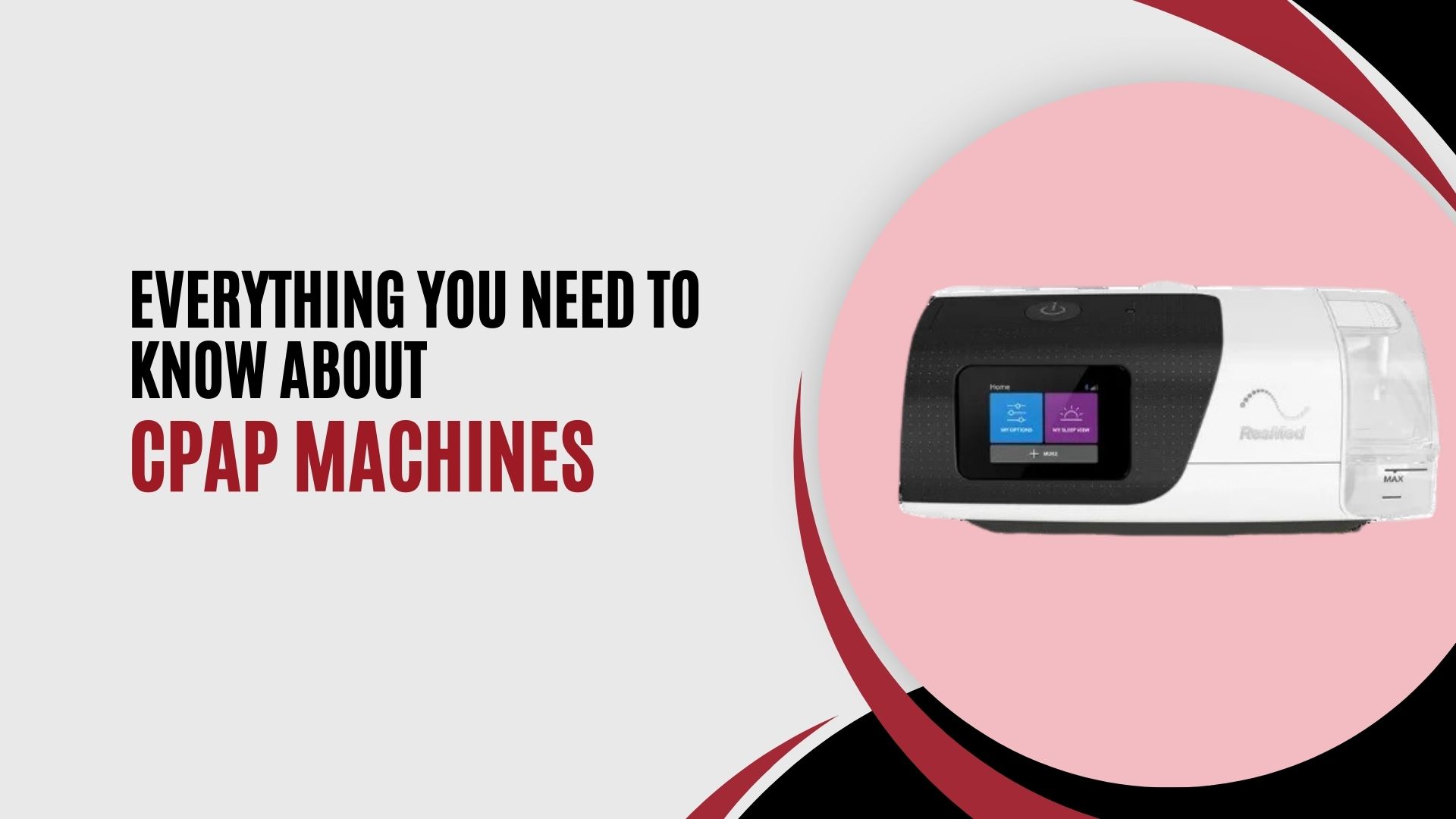Many people think sleep apnea is just loud snoring. But sleep apnea can be serious. In short, it can make it hard to sleep. Over time, it can lead to health problems like high blood pressure and diabetes. It can also increase the risk of heart attacks and strokes.
Obstructive sleep apnea (OSA) is the most common type. CPAP devices are the best treatment for OSA.
This guide explains how CPAP machines work. It also talks about their main benefits. You will find tips for taking care of them and advice on how to pick the right one for you.
What Is Sleep Apnea?
Sleep apnea happens when your breathing stops for a short time during sleep. This is because the tongue or soft tissue blocks your throat. Dr. Igal Elyassi, founder of The Sleep Apnea Center, says the brain tells you to breathe deeper. This can wake you up. It can interrupt your sleep. Many people don’t know they have sleep apnea, but their partner might notice. In the U.S., 25 million out of 70 million people with sleep problems have sleep apnea.
What is a CPAP Machine?
A CPAP machine helps treat sleep apnea. It gives continuous positive airway pressure. This keeps the airway open while you sleep. It stops breathing problems during sleep. CPAP therapy is effective for both obstructive and central sleep apnea.
How Does a CPAP Machine Work?
A CPAP machine helps keep your airway open while you sleep. It blows pressurized air to stop your airway from closing. The machine has three main parts: the main unit, a tube, and a mask. These parts work together.
CPAP Machine (Main Unit)
The main unit is the heart of the CPAP machine. It has a motor that produces pressurized air, which keeps your airway open. You can adjust the air pressure using the settings display. Some machines have a humidifier to prevent your nose and throat from drying out. CPAP machines are usually small, quiet, and easy to travel with.
Flexible Tube
The tube links the main unit to the mask. It carries pressurized air to your airway. Tubes come in different lengths, like 6, 8, or 10 feet. This helps you move easily while sleeping. The machine cleans the air before it goes through the tube.
Mask (Interface)
The mask lets air enter your airway. It connects to the tube and comes in different types. Nasal masks cover your nose, while full-face masks cover your nose and mouth. Nasal pillows fit inside your nostrils and are lightweight. Straps hold the mask in place to prevent air leaks. A comfortable mask is important for good treatment.
What’s the Difference Between CPAP, APAP, and BiPAP Machines?
PAP machines are used to help with breathing during sleep. They are different in how they give air pressure:
- CPAP gives constant air pressure.
- APAP adjusts the pressure automatically.
- BiPAP gives different pressure levels.
CPAP
CPAP stands for Continuous Positive Airway Pressure. It gives your airways a steady flow of air pressure when you sleep. This is also called a fixed-level CPAP. A sleep specialist sets the pressure level during a sleep study.
APAP
APAP stands for auto-adjusting PAP. These machines change air pressure based on your breathing. Unlike CPAP machines, they do not use a fixed air pressure. Instead, the APAP machine adjusts it automatically.
A sleep specialist sets the upper and lower pressure limits. Within these limits, the machine changes the air pressure as needed. This helps match your breathing patterns and gives the right amount of support.
BiPAP
BiPAP devices provide two air pressure levels: one for inhaling and the other for exhaling. They provide higher pressure when you breathe in and lower pressure when you breathe out.
Doctors often recommend BiPAP for people who struggle with regular CPAP therapy. It is also used for people with serious breathing problems or conditions like central sleep apnea.
Types of CPAP Machines
CPAP machines are different based on the masks they use. The best mask for you depends on your comfort, breathing, and type of sleep apnea. Here are the main types of CPAP masks:
Nasal Mask:
This mask covers your nose. Please move a lot while sleeping.
Nasal Pillow Mask:
This mask only covers the area around your nostrils. Some have prongs that go inside your nostrils. With this type of mask, you can easily wear glasses.
Full Mask:
This mask covers both your nose and mouth. It is best to breathe through your mouth or have a blocked nose.
Hybrid Mask:
This mask covers your mouth and seals your nostrils with prongs or cushions. It does not cover the bridge of your nose.
Pros and Cons of Using a CPAP Machine
Pros
- Helps you sleep better without waking up.
- Lowers the risk of heart attack and stroke.
- Reduces high blood pressure.
- Less daytime sleepiness.
- It may lower blood sugar and cholesterol.
- It improves mental health by reducing anxiety and depression.
- Boosts focus and productivity with better brain functions.
- Stop snoring, giving peaceful sleep to you and your partner.
- Keeps oxygen levels steady for better health.
- Increases energy by reducing daytime tiredness.
- Prevents memory problems from untreated sleep apnea.
- Eases acid reflux and GERD symptoms.
- Stops morning headaches from low oxygen levels.
Cons
- Long-term use might make you depend on it.
- Adjusting air pressure can be hard for some.
- It’s not good for every sleep apnea patient.
- It was hard to sleep comfortably at first.
- It may cause anxiety or fear.
- It can block your nose.
- It might dry out your mouth.
- Travelling or power cuts make it inconvenient.
- Machines and parts can be expensive.
- It might cause jaw pain or tooth problems over time.
- Nosebleeds are possible.
- Masks may irritate your skin.
- Air might make you feel bloated.
- Machine noise can bother light sleepers.
- It needs cleaning to avoid germs and allergies.
Tips for Comfortably Using a CPAP Machine
Choose the Right Mask
Pick a mask that fits well, not too tight. Try full-face masks, nasal masks, or nasal pillows to find the best one. Adjust the straps so it stays snug without hurting.
Start Slowly
Wear your CPAP mask during the day to get used to it. Use it while watching TV or reading. Once comfortable, use it for short times at night and increase slowly.
Fix Dryness or Irritation
Use a humidifier or heated tubing to stop dryness. Saline spray can keep your nose moist. Adjust the settings to avoid irritation.
Set the Machine Right
Work with your doctor to ensure the machine pressure is correct. Use the ramp-up feature to start with low pressure, then increase as you sleep.
Keep It Clean
Wash the mask, tubing, and humidifier often with soapy water. Replace air filters as recommended for better performance.
Sleep Comfortably
Check for and fix air leaks. Use a CPAP pillow for better sleep positions. Try sleeping on your side to improve comfort and reduce apnea.
Handle Discomfort
Feeling anxious? Practice deep breathing or relax before bed. If needed, contact your doctor or CPAP supplier for advice or adjustments.
Be Consistent
Use your CPAP machine every night, even for naps. Stick to a routine to get the best results. Track your progress with CPAP apps.
Ask for Help
If problems persist, contact your sleep specialist or supplier. They can make changes to improve your comfort and therapy.
How to Clean a CPAP Machine
Keeping them clean is important. Germs from your mouth, throat, or skin can spread to the machine, and dust, mould, and allergens can also collect inside. Clean it often to stay healthy and keep the machine working.
Before cleaning:
- Check the manual for cleaning instructions.
Steps to clean your CPAP:
- Unplug the machine.
- Take apart the mask, hose, and tubing.
- Wash the mask with mild soap and warm water.
- Clean the tubing by filling it with warm, soapy water.
- Wash the hose the same way.
- Clean the cushion and headgear with mild soap.
- Rinse all parts with clean, cool water.
- Let everything air dry on a clean towel.
- Hang the hose and tubing to dry completely.
- Wipe all parts with a dry towel if needed.
- Put the CPAP machine back together.
Keep your CPAP clean to stay healthy and make it last!
How to Select the Right CPAP Machine for You
CPAP machines are medical devices. You can only get one with a prescription. If your doctor or sleep specialist finds you have sleep problems, they may suggest CPAP therapy. They will likely choose the best CPAP machine for you. You can ask questions or share your thoughts if the machine is wrong.
The Last Word from Sleephapp Medical
Sleep apnea is a common sleep problem affecting 25 million people. It can be managed with good treatments.
CPAP devices are the best treatment for sleep apnea, but they don’t work for everyone. If CPAP feels too uncomfortable, talk to your doctor. Ask about other treatments or new options for sleep apnea care.
Frequently Asked Questions
Does Medicare Cover CPAP Machines?
If your doctor says you have obstructive sleep apnea and your doctor and CPAP supplier are enrolled in Medicare, Medicare can help pay for part of your CPAP machine. At first, they might only pay for a three-month trial. After that, you will need more doctor visits to keep getting coverage. You may still have to pay 20% of the cost for the CPAP machine and supplies, like the mask and tube.
How Much Do CPAP Machines Cost?
CPAP machines usually cost between $500 and $1,000, but the price can be higher for machines with more features.
How Do CPAP Machines Know When You Stop Breathing?
A fixed-air CPAP releases air at the same pressure all the time. It doesn’t change whether you are breathing normally or not. An APAP machine, however, uses sensors and technology. It can tell when you slow down or stop breathing. Then, it changes the airflow to match your needs.
The APAP machine can also count the number of times you stop or slow your breathing each night or hour and detect if the mask is leaking air.










